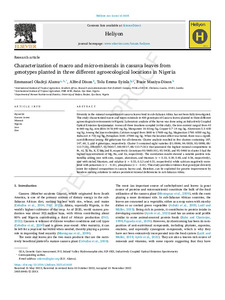Welcome to the International Institute of Tropical Agriculture Research Repository
Characterization of macro and micro-minerals in cassava leaves from genotypes planted in three different agroecological locations in Nigeria
| dc.contributor.author | Alamu, E.O. |
| dc.contributor.author | Dixon, A. |
| dc.contributor.author | Eyinla, T. |
| dc.contributor.author | Maziya-Dixon, B. |
| dc.date.accessioned | 2023-04-17T07:00:01Z |
| dc.date.available | 2023-04-17T07:00:01Z |
| dc.date.issued | 2022-11 |
| dc.identifier.citation | Alamu, E.O., Dixon, A., Eyinla, T. & Maziya-Dixon, B. (2022). Characterization of macro and micro-minerals in cassava leaves from genotypes planted in three different agroecological locations in Nigeria. Heliyon, 8(11): e11618, 1-18. |
| dc.identifier.issn | 2405-8440 |
| dc.identifier.uri | https://hdl.handle.net/20.500.12478/8132 |
| dc.description.abstract | Diversity in the mineral composition of cassava leaves bred in sub-Saharan Africa has not been fully investigated. This study characterized macro and micro-minerals in 400 genotypes of Cassava leaves planted in three different agroecological environments in Nigeria. Laboratory analysis of the leaves was done using an Inductively Coupled Optical Emission Spectrometer. Across all three locations sampled in this study, the iron content ranged from 43 to 660 mg/kg, zinc from 16 to 440 mg/kg, Manganese 16–61mg/kg, Copper 0.7–14 mg/kg, Aluminum 5.3–630 mg/kg. Among the macro elements, Calcium ranged from 3600 to 17600 mg/kg, Magnesium 1760–6500 mg/kg, Sodium 0.4–720 mg/kg, Potassium 3100–27000 mg/kg. When the location effect was tested, there was a significant difference among the genotypes for all elements. Cluster analysis resulted in five clusters containing 187, 147, 60, 2, and 4 genotypes, respectively. Cluster 2 contained eight varieties (01/0046, 94/0020, 93/0098, 88/112-7(3X), I00/0017, 91/00417, I00/0017, 88/112-7(3X)) that possessed the highest mineral compositions in Fe, Al, Ti, Na, K, S, Mn, and B, respectively. Genotypes 93/0681(4X), 92/0430, and 95/0460 in cluster 3 had the highest concentrations of Mg, Na, and Zn, respectively. The correlation results showed a notable positive relationship among iron with zinc, copper, aluminum, and titanium (r = 0.33, 0.39, 0.48, and 0.56, respectively), zinc with nickel, titanium, and sulphur (r = 0.52, 0.3,2 and 0.51, respectively) while calcium negatively correlated with potassium (r = ‒ 0.31), phosphorus (r = ‒0.41). This study provides evidence that genotypic diversity exists for mineral composition in cassava leaves and, therefore, can be exploited for genetic improvement by breeders seeking solutions to reduce persistent mineral deficiencies in sub-Saharan Africa. |
| dc.format.extent | 1-18 |
| dc.language.iso | en |
| dc.subject | Cassava |
| dc.subject | Leaves |
| dc.subject | Minerals |
| dc.subject | Nigeria |
| dc.subject | Iron |
| dc.subject | Zinc |
| dc.subject | Genotypes |
| dc.title | Characterization of macro and micro-minerals in cassava leaves from genotypes planted in three different agroecological locations in Nigeria |
| dc.type | Journal Article |
| cg.contributor.crp | Agriculture for Nutrition and Health |
| cg.contributor.crp | Maize |
| cg.contributor.crp | Roots, Tubers and Bananas |
| cg.contributor.affiliation | International Institute of Tropical Agriculture |
| cg.coverage.region | Africa |
| cg.coverage.region | West Africa |
| cg.coverage.country | Nigeria |
| cg.coverage.hub | Southern Africa Hub |
| cg.coverage.hub | Headquarters and Western Africa Hub |
| cg.researchtheme | Nutrition and Human Health |
| cg.identifier.bibtexciteid | ALAMU:2022f |
| cg.isijournal | ISI Journal |
| cg.authorship.types | CGIAR Single Centre |
| cg.iitasubject | Agronomy |
| cg.iitasubject | Cassava |
| cg.iitasubject | Food Security |
| cg.iitasubject | Genetic Improvement |
| cg.iitasubject | Nutrition |
| cg.iitasubject | Plant Genetic Resources |
| cg.iitasubject | Plant Production |
| cg.journal | Heliyon |
| cg.notes | Open Access Journal; Published online: 16 Nov 2022 |
| cg.accessibilitystatus | Open Access |
| cg.reviewstatus | Peer Review |
| cg.usagerightslicense | Creative Commons Attribution 4.0 (CC BY 0.0) |
| cg.targetaudience | Scientists |
| cg.identifier.doi | https://doi.org/10.1016/j.heliyon.2022.e11618 |
| cg.iitaauthor.identifier | Alamu Emmanuel Oladeji: 0000-0001-6263-1359 |
| cg.iitaauthor.identifier | Busie Maziya-Dixon: 0000-0003-2014-2201 |
| cg.futureupdate.required | No |
| cg.identifier.issue | 11: e11618 |
| cg.identifier.volume | 8 |

